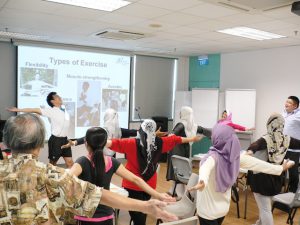Keeping the pounds off
As you age, there is a decrease in muscle mass and an increase in body fat. Here’s the good news – you can still shed the extra pounds and we give you some ideas on how to do it.
BY: Uma Padmanabhan
In contemporary society, age is not merely a number, but an ‘attitude’ and nowadays, 60 is the new 40! However, physiologically, advancing age is often associated with a very visible increase in the accumulation of body fat. Concurrently, not so visible, is the steady and rapid decrease in muscle mass.
Increasing body weight exposes one to the risk of numerous chronic diseases such as diabetes, cardiovascular diseases, arthritis and cancer. Additionally, the reduction in muscle mass has an impact on one’s strength, leading to a decrease in one’s capacity to perform daily living tasks such as walking, carrying things, and even increasing the risk of falls and fractures.
Those over 50 years of age, who have not previously grappled with fluctuating body weights, are often bewildered with their changing bodies, and quite perplexed on how to manage these changes. Weight loss is however only successful when it is accompanied by behaviour change. There is overwhelming evidence that irrespective of age or BMI, increasing physical activity and consuming a healthy diet can improve muscle mass and also help in managing body weight. Therefore no one is too old to enjoy the benefits of a healthy lifestyle.
Engaging in physical activity does not necessarily mean taking a gym membership. Physical activity can be increased on a daily basis by reducing the time being sedentary (sitting activities) at home and at work.
Here’s how to get started and shed some pounds:
- At home you can increase your physical activity by doing simple chores like cooking, cleaning, or even ironing clothes.
- Take the stairs instead of the lift. Start by climbing one floor and then taking the lift. When you feel comfortable, add another floor and/or combine stair climbing with the lift.
- Decrease the time spent sitting at home. Try and do your chores standing-up. When watching TV, get up when the advertisements go on and spot walk/jog. Alternatively, do some stretching exercises.
- Avoid shopping for groceries when you are hungry, and opt for the basket instead of a cart. This will strengthen your arms as well as prevent you from just tossing unwanted food items into the cart.
- Join your friends for a brisk walk in the morning and/or evening. Or go cycling if there is a safe cycle path near your house.
- Take part in regular tai chi, qigong, pilates or yoga classes. It will improve your balance, and make you flexible and prevent those falls.
- Engage in strength training exercises at least twice a week. It’s ok if you do not have weights, use a plastic bottle that has a good grip and fill it with water or sand, or use exercise bands.
- To continue accruing the benefits of physical activity, keep modifying your routine physical activity patterns periodically by changing the duration or intensity of the activity every couple of weeks. This allows you to keep your exercise routine less of a routine.
- Change your usual plate/bowl for a smaller one. This will help you automatically reduce your portion size. And if you can’t finish your food, don’t force yourself to finish it. Also, avoid late-night suppers as they can be add to your weight.
- Chew your food slowly and take the next mouthful only after you have already swallowed the previous one. Avoid reading or watching TV when eating. Instead be conscious of the different taste sensations, and be aware of the messages you receive from your body to avoid overeating. Also, watch what you eat such as fried or sweet food as these can add unwanted pounds and increase your risk of health conditions.
- While commuting, park your car away from the main door, or alight one or two stops prior to your bus-stop or MRT. This way you can get a good brisk walk in before you get into the office.
- Leave a couple of minutes later than usual to catch the bus/MRT. This will make you walk faster to reach in time.
While the body adapts positively to increased physical activity, the benefits gained can be easily lost when inactive for long periods of time. Therefore, engaging in some form of physical activity is preferable to none. However, be aware of the safety aspects and ensure that you start slowly and always listen to your body.
|
SIDEBOX: For more information on the current programmes led by Health Promotion Board which can help you start, modify, or even help in maintaining your healthy lifestyle, visit the following websites: • Strength Training Exercise Program for older adults (>60 yrs) – a group exercise programme – http://www.hpb.gov.sg/functionalscreening.aspx, tel: Healthline – 1800 223 1313, e-mail: HPB_CFSP@hpb.gov.sg • For nutritious recipes made easy – http://one.pa.gov.sg – search under ‘courses’ • National Brisk walking program – access different CDC’s CS CDC: www.centralsingaporecdc.org.sg • Healthier restaurant program – http://www.hpb.gov.sg/foodforhealth • Mind-body exercise or qigong – http://www.hpb.gov.sg/physicalactivity/article.aspx?id=8646 • Lose to win challenge – www.hpb.gov.sg/losetowin |
Uma Padmanabhan is the manager of the Health Promotion Board’s Physical Activity Centre of Excellence.



0 Comments